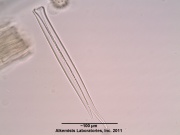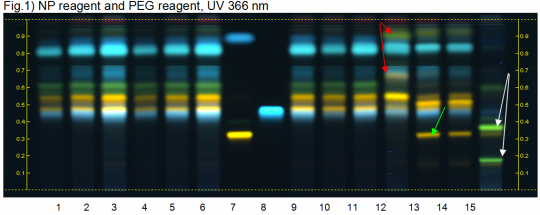Arnica montana (flower)
Contents |
Introduction
Macroscopic Entries
|
Microscopic Entries
|
HPTLC Entries
|
Arnica (flower) (Arnica montana) Lane Assignments Lanes, from left to right (Track, Volume, Sample):
Reference Sample(s) Reference: Dissolve 2 mg of caffeic acid, 3.5 mg of rutin and 2.5 mg of chlorogenic acid individually in 5 mL of methanol. Stationary Phase Stationary phase, i.e. Silica gel 60, F254 Mobile Phase Ethyl acetate, formic acid 98%, water, ethyl methyl ketone 50:10:10:30 (v/v/v/v) Sample Preparation Method Sample: Mix 1 g of powdered sample with 10 mL of methanol and sonicate for 10 minutes, then centrifuge or filter the solutions and use the supernatants / filtrates as test solutions. Derivatization reagent: 1.) NP reagent Preparation: 1 g of natural products reagent in 200 mL ethyl acetate 2.) PEG reagent Preparation: 10 g of polyethylene glycol 400 in 200 mL methylene chloride Use: Heat plate for 3 min at 100°C, dip (time 0, speed 5) in NP reagent while still hot, dry and dip (time 0, speed 5) in PEG reagent Detection Method Saturated chamber; Developing distance 70 mm from lower edge; Relative humidity 33% Other Notes Images presented in this entry are examples and are not intended to be used as basis for setting specifications for quality control purposes. System suitability test: Rutin: orange fluorescent zone at Rf ~ 0.32; chlorogenic acid: bluish fluorescent zone at Rf ~ 0.46; caffeic acid: bluish fluorescent zone at Rf ~ 0.89 Identification: Compare result under UV 366 nm with reference images. The fingerprint of the test solution is similar to that of the corresponding botanical reference sample. Additional weak zones may be present. The chromatogram of the test solution shows a blue-white zone corresponding to chlorogenic acid. There are two yellow zones and a green zone above the reference material chlorogenic acid. At the upper part of the chromatogram there are one to two blue-white zones. Below the NOTE: No prominent zone is seen at or below the position of rutin. Test for adulteration: No greenish fluorescent zone is seen at or just above the position of caffeic acid and no yellow fluorescent zone is seen at Rf ~ 0.65 (red arrows; Chamisso arnica (flower)). No yellow zone is seen at the position of rutin (green arrow; False arnica flower). No green zone is seen below or just above the position of rutin (white arrows; Calendula flower).
|
Other Points of Interest
Cite error: <ref> tags exist, but no <references/> tag was found


